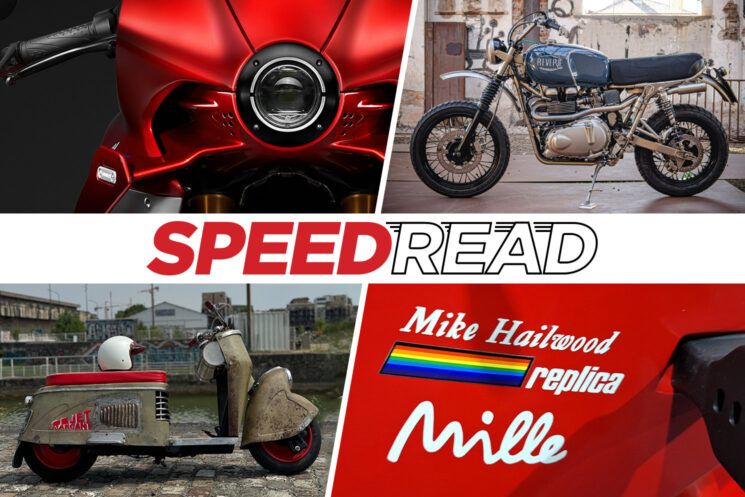
Leading the charge this week is the unusual combination of a rare French vintage scooter with a modern Honda powertrain. We also feature a stylish Triumph Bonneville, a barely touched Ducati MHR Mille, and the shiny new MV Agusta Serie Oro 1000.
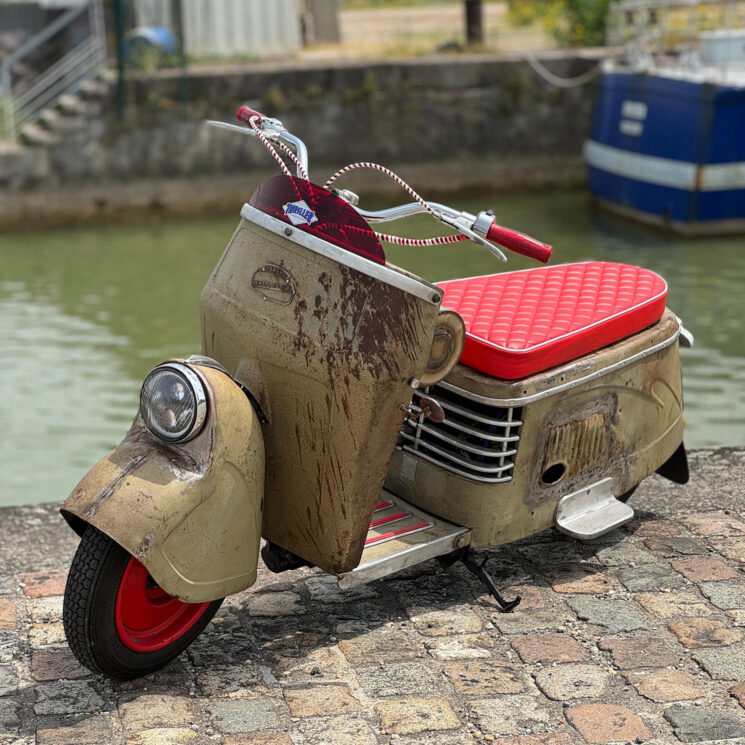
Bernardet x Honda hybrid scooter by Seb’s Atelier and Objet Marcant Having just returned from a trip to Italy, the urge to buy a classic Vespa or Lambretta is exceedingly strong. On the graph of life, age, and taste are directly correlated with how much sense scooters make—even if they are the oft-maligned segment of the two-wheeled world. They are cheap (-ish) to buy, cheap to run, and far more practical than a traditional motorcycle thanks to their onboard storage and lack of gears.
Today, Japanese, Taiwanese, and Chinese-made scooters are more common than anything else, but in the 1940s, manufacturing at a local level was more common. That gave rise to boutique European companies like Bernardet. Founded by the three Bernardet brothers, the company started by making sidecars in a small workshop just south of Paris.
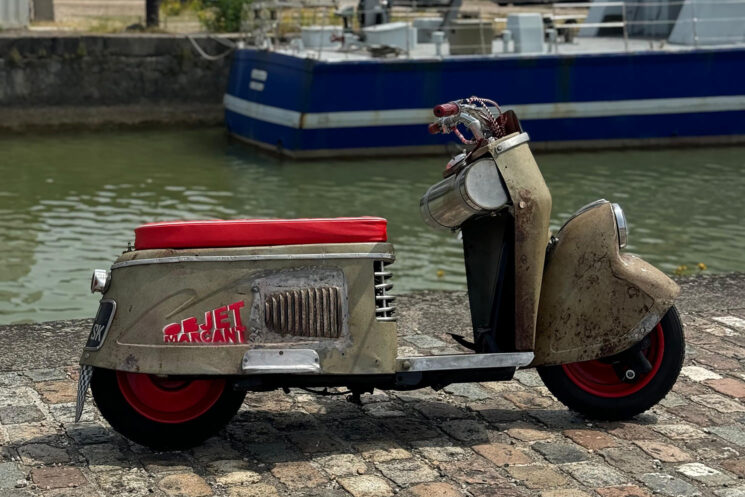
Efforts eventually turned to making scooters between 1947 and 1959. The bodies and running gear were made by Bernardet, while the engines were provided by Ydral, Marcel Violet, and (eventually) Bernardet themselves.
Parts from those brands are hard to find these days, which makes old Bernardet scooters difficult to maintain. This is the exact situation that Seb Ledis of Seb’s Atelier and Marc-Antoine Giorgi of Objet Marcant found themselves in with this beautiful 1952 Bernardet C50. Luckily, they had a plan…
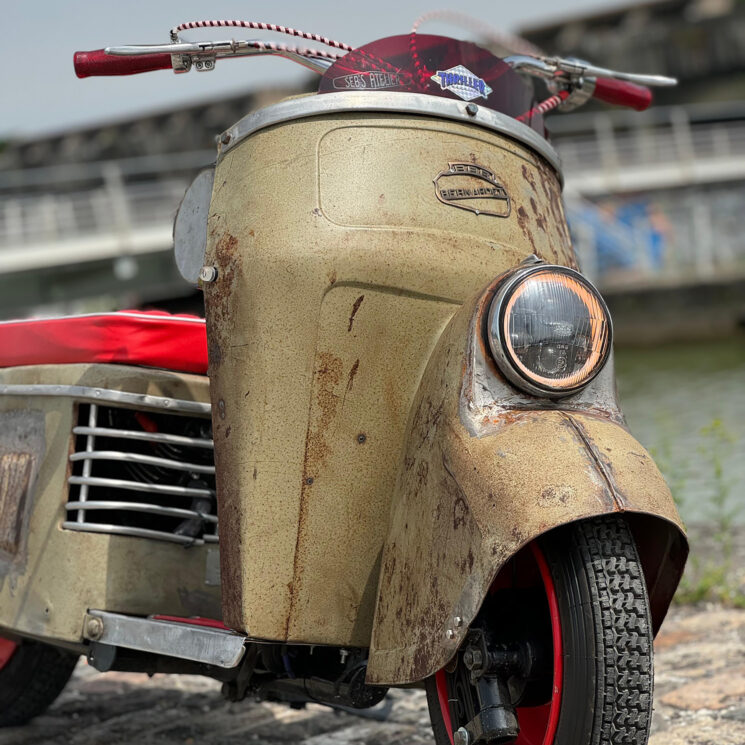
Replacing the original 125 cc Ydral engine with one from a 1997 Honda NX125 was the solution. After many nights (and beers), the marriage between the 72-year-old scooter and the much younger engine was complete. The engine capacity was the same, but the Honda engine was more than twice as powerful and infinitely easier to service and maintain. Seb and Marc-Antoine also made a custom 12 V wiring loom and converted all the lighting to LED.
The engine is now running a Suzuki carburetor and a custom exhaust. A Volkswagen Beetle gear selector mechanism was mated to the six-speed transmission (which sounds like a complete hoot). A new fuel tank was added above the rider’s knees, sitting in front of a diamond-stitched red leather seat.
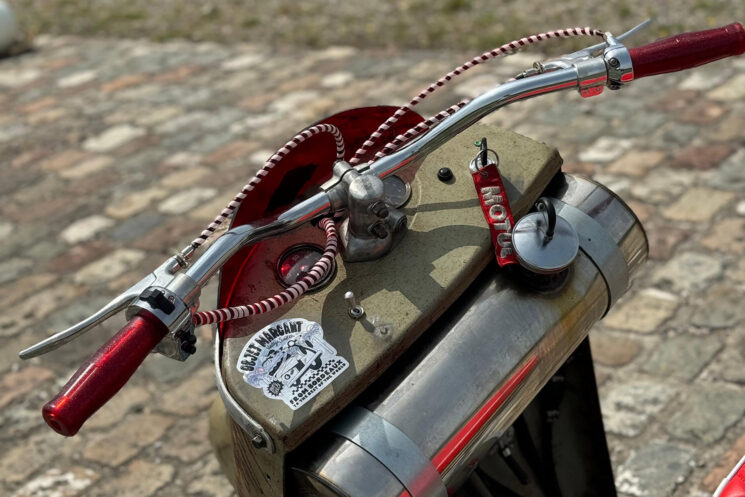
The wheels were painted to match the seat and hand-painted Objet Mercant logo. The front fender is from a Vespa and the ventilation vents on the rear of the body are from a rare Manurhin scooter. The flat track handlebar’s red glitter grips match the red polycarbonate screen.
It’s an exceptionally beautiful art deco design that looks incredible with its 70-plus years of authentic patina. Our hats are off to Seb and Marc-Antoine for perfectly blending old with new. [Source]

Triumph Bonneville scrambler by Reverie The 790 cc air-cooled Triumph Bonneville is a bike that introduced a lot of people to the café racer and custom motorcycle scene. The Bonneville lineup still exists today and is one of the best modern classic options out there—but it’s also become more powerful, and, by extension, more complex and expensive.
This stunning custom Bonneville scrambler from Reverie is based on a 2005-model Triumph Bonneville 790. The 790 cc engine has the distinctive sound of a 360-degree parallel twin, with two valves per cylinder, a pair of carburetors, and not much else. It’s a wonderfully simple machine with all the allure of a vintage motorcycle, but without the oil leaks.
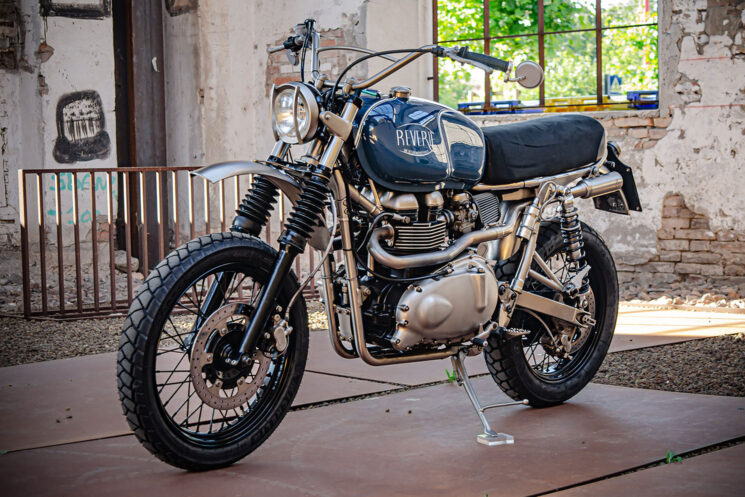
Reverie tore into the Bonneville, stripping it down to its nuts and bolts. The frame was nickel plated and the fuel tank is custom made from a carbon-kevlar composite. The rear subframe was chopped, looped, and finished with a custom leather and Alcantara seat.
The tank-seat combination is decidedly desert sled, so alloy fenders were mounted up high to match, along with a scratch-made high-mounted exhaust. The high-mounted exhaust highlights the beautiful double-cradle frame of the Bonneville, while the subtle nickel plating on the frame sets it off just enough to contrast it against the black and silver engine paint.

The front suspension was upgraded with rebound and compression adjusters, and the rear suspension was replaced with longer, remote reservoir shock absorbers. The 19F/17R spoked wheels were wrapped in Michelin Anakee Adventure tires. The rider’s cockpit area was kept slim, with the speedometer embedded into the tank. The carbs were re-jetted to suit the pod filters and the oil cooler was removed, with the oil now running through the frame like Triumphs of yore.
The air-cooled Bonneville has been one of the most cost-effective entry points into classic motorcycling over the years—so it’s always good to see a well-sorted one kicking around. [Source | Via]
![]()
For sale: 1985 Ducati MHR Mille Earlier this week, we profiled a showstopping café racer based on the rare Ducati MHR Mille. But if you absolutely must favor the original, there’s a barely-used example currently for sale over at Iconic Motorbikes in the USA. And it’s as alluring as they come.
If you’re not au fait with the MHR Mille’s history, we’ll fill you in. It starts with one of the greatest tales in motoring: Mike ‘The Bike’ Hailwood’s 1978 comeback at the Isle of Man TT.
![]()
Before he retired from Grand Prix racing in 1967, Hailwood was one of the most decorated riders in history with 76 wins and 112 podiums from 152 starts. He was also a master of the Isle of Man TT, with 14 wins and 19 podiums to his name.
However, it was his 1978 win at the Isle of Man TT that was the most historic. Hailwood had been retired from Grand Prix motorcycle racing for eleven years but had continued to ride in non-championship events all over the world. He surprised everyone by turning up at the 1978 Isle of Man TT with a Ducati 900SS provided by Sports Motorcycles, the UK-based Ducati dealer.
![]()
Nobody thought he would even be competitive, let alone win the race. Ducati themselves were so impressed that they decided to release the 900 MHR (Mike Hailwood Replica) to honor the man himself. It was here again that the allure of the Hailwood name proved the naysayers wrong.
The initial run of 200 homologation bikes in 1979 sold out so quickly that Ducati decided to keep production going until 1986. When it was all over, Ducati had sold around 7,100 MHRs—making it the best-selling bevel-drive twin Ducati ever made.
![]()
The bike was originally a 900SS with updated fairings (just like the bike Mike rode to victory), but over the years it grew in engine capacity and extra features were added. The original bikes were intended to be pure race replicas and didn’t even have an electric starter or rubber footpegs.
The bike you see here is a 1985 model MHR Mille. Along with the larger engine, the MHR Mille featured adjustable Verlicchi clip-on handlebars, updated instrumentation, rubber inserts on the footpegs, a hydraulically actuated clutch, and an all-important electric starter. It also featured a Conti exhaust and larger Brembo brakes.
![]()
Around 1,100 MHR Milles were built, and they were the last bevel-drive twins that Ducati made. This alone makes them extremely desirable machines.
This MHR Mille in particular is being offered for sale with just 1.5 miles on the odometer. The bike is currently in Australia, having spent most of its life in Japan, and the last decade at the Australian Motor Museum. It’s safe to say that the bike has only been started a few times in its life—so it’s begging to be bought, serviced, and put back into action. [More]
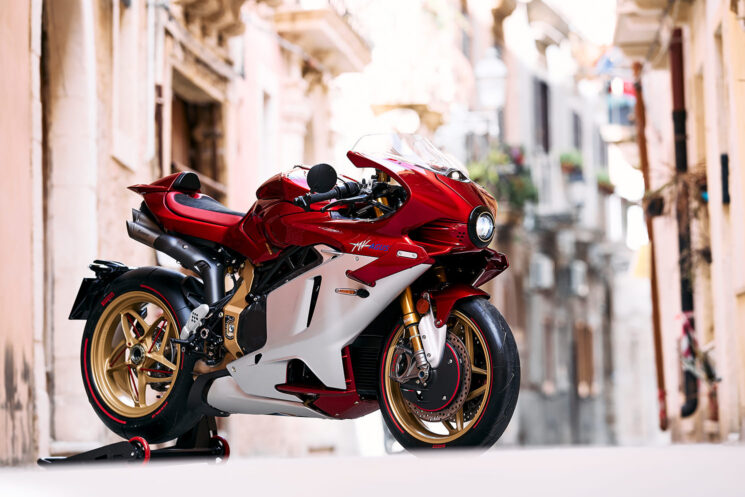
New MV Agusta Superveloce Serie Oro 1000 Given the choice of any sportbike from the last five years to put in the fictional Bike EXIF garage, I’d go with the MV Agusta Superveloce. The retro-yet-futuristic design, the timeless livery, and the fabulous bill of materials have had me drooling over the Superveloce since its release in 2020.
Starting with the F3 800 as a base, the MV Agusta design team wanted to give the modern sportbike some classic styling. The Italian brand has a stunning history, so there was no better place to draw inspiration from than its lineup of historic three-cylinder Grand Prix machines. Who knew that artfully draping 1960s- and 1970s-inspired bodywork over a brand-new bike could result in such an outrageously good-looking machine?
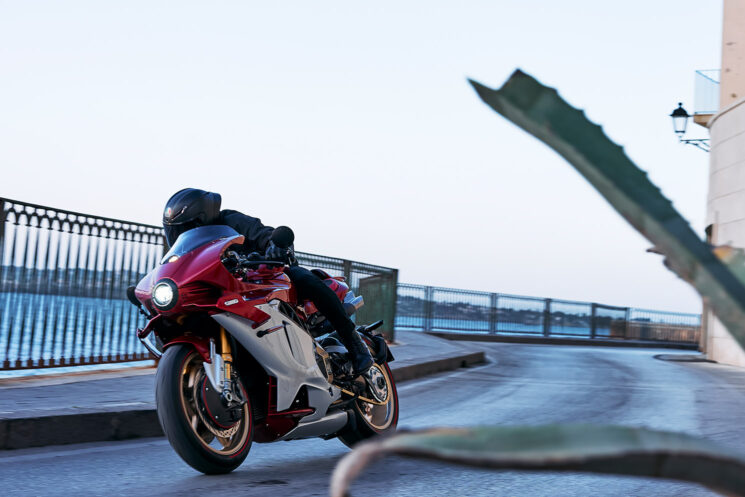
Now entering its fourth year of production, MV Agusta has just unveiled the new Superveloce 1000 Serie Oro. And goodness me, what a thing it is.
The first thing that jumps out is the drop-dead gorgeous red and silver paint, laid over the newly-designed fairings and bodywork. What started as smooth and elegant bodywork has, four years later, become more angular and sharp. It looks just as fantastic as before though, only more modern—and nothing screams ‘modern sportbike’ like big ‘ol aero wings.
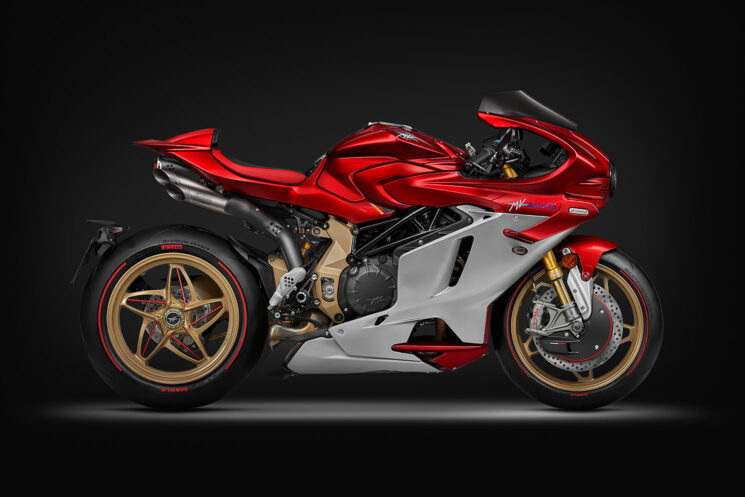
The rear end is more aggressive than the original too, especially framed by the quad-exit titanium exhaust system from Akrapovič. The new seat is leather and Alcantara, and titanium fasteners have been used throughout the bike with reckless abandon.
Like the premium Superveloce models MV Agusta offered in the past, the 1000 Serie Oro features carbon fiber as far as the eye can see (well, most of it is hidden under the paint, but it’s still there). The ‘1000’ part of the name denotes the engine’s capacity, with the 1000 Serie Oro housing a 1,000 cc four-cylinder engine instead of the 800 cc triple found in the F3.
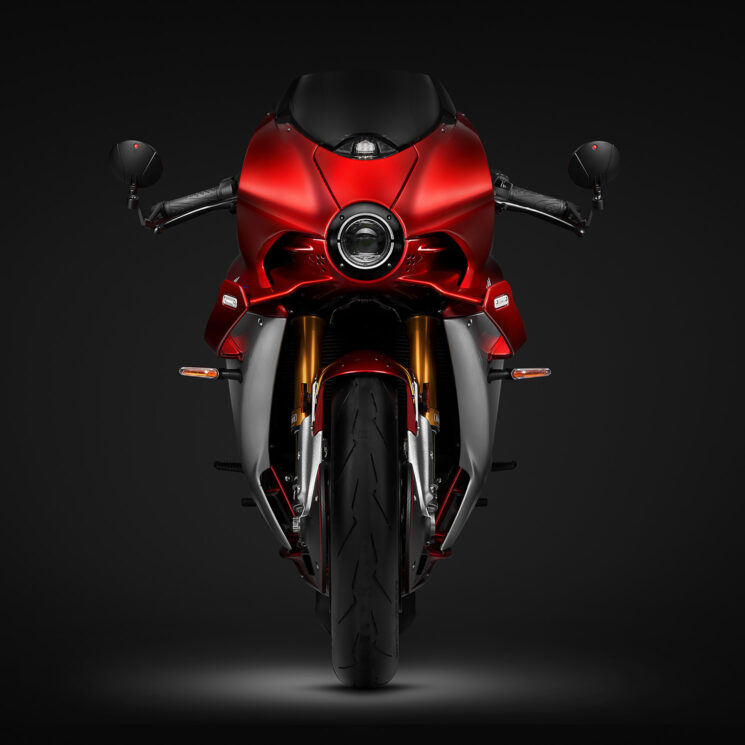
Brembo brakes and electronically adjustable Öhlins suspension are featured at both ends of the bike. To go one step further (and to justify the undeniably high price the bike will attract), Pirelli developed a special version of their Supercorsa SP V4 tire for the bike, which features a red sidewall stripe and red Pirelli logos.
Limited to just 500 units, the 1000 Serie Oro is the best version of the Superveloce yet. And just like its predecessors, it’ll probably be sold out in no time. [MV Agusta]

from Bike EXIF https://ift.tt/XBtFs8P
No comments:
Post a Comment